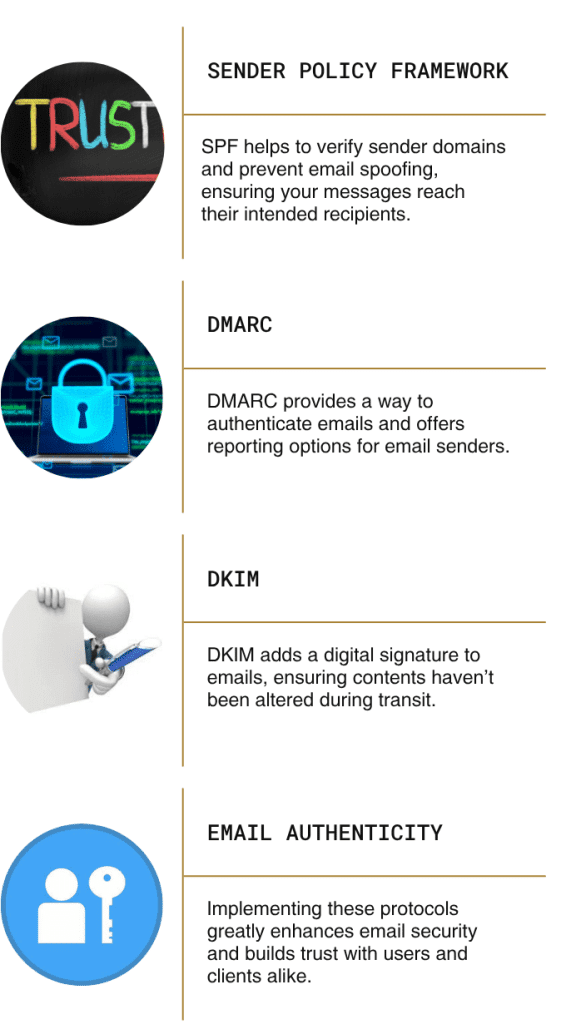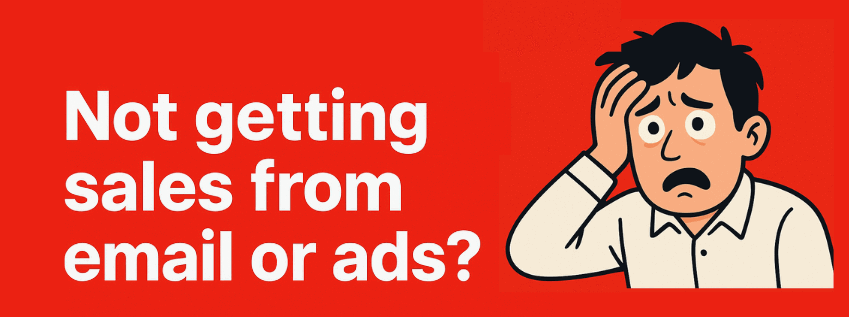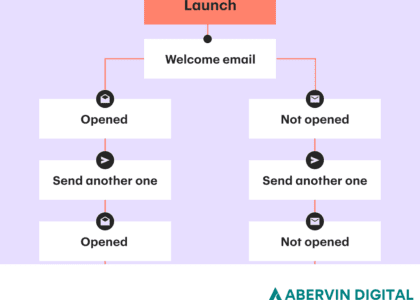Ever pour hours (and dollars) into email campaigns, maybe even run ads on Google or Facebook… only to stare at analytics that look flatter than a pancake?. You’ve got no sales coming in. No meaningful clicks. Just crickets.
If that’s you, you’re not alone. Most small and mid-sized businesses struggle to convert their marketing into revenue. And here’s the truth: it’s usually not because your product isn’t good or because “email marketing doesn’t work anymore.”
The problem with any holistic marketing process tends to fall into three big buckets: deliverability, funnel design, and ad setup.
Today, we’ll break each one down, show you why they’re silently costing you sales, and most importantly, give you actionable fixes so you can stop guessing and start scaling.
The Real Reason Your Marketing Isn’t Converting
The biggest misconception small businesses have is thinking more volume = more sales.
Sending more emails or spending more on ads won’t fix a broken system. If your emails don’t land in the inbox, your funnels don’t guide prospects clearly, or your ads aren’t targeting buyers, you’re just pouring money into a leaky bucket.
Think of your marketing like running a relay race.
Your ad (or email) is the runner who carries the baton. The funnel is the next runner waiting to grab it. And your offer…the thing people actually buy, is the finish line.
If any runner trips (bad targeting, poor copy, broken funnel steps, spam folder issues), the baton never makes it.
So the question isn’t: “Do ads work?” or “Is email dead?”
The real question is: “Where’s the handoff breaking down in my system?”. That’s what we’re going to uncover in this blog.
Quick diagnostic – Do this first (30 – 60 seconds)

Before you rip apart your whole marketing strategy, let’s slow down and check the basics.
This 60-second “quick diagnostic” is a three-question short checklist that instantly shows you which part of your system is leaking money. Run through them right now and jot down where you see a red flag.
1. Are your email open rates under industry benchmarks? (email deliverability clue)
If your emails aren’t even being opened, that’s a flashing warning sign about deliverability. Translation: your emails might be landing in spam, promotions, or just not showing up where people can see them.
Here’s a rough industry baseline:
- E-commerce brands: 20–25% open rate
- Service businesses: 25–30%
- B2B companies: 15–20%
If you’re sitting way below that, then you should look into cleaning up your sending reputation. That’s where email deliverability best practices come in (like warming your domain, trimming dead contacts, and tightening subject lines so they don’t look spammy).
2. Are clicks high but conversions low? (funnel/content clue)
Okay, so let’s say people are opening your emails and clicking on your links that’s awesome. But if sales are still flat, then the issue isn’t deliverability. It’s what happens after they click.
This usually points to a broken email funnel or weak landing pages. Your funnel is the path from “I’m interested” to “Here’s my card.” If that path has potholes (too many steps, confusing copy, bad design, or an offer that feels off), people bounce before buying.
That’s where sales funnel optimization comes in. Even small fixes like making sure your CTA button is above the fold, or that your product page answers objections right away, can move the needle fast.
3. Are you getting traffic but few qualified leads? (ad setup clue)
Finally, let’s zoom out. Maybe your emails are clean and your funnel looks solid but you’re still not seeing sales. That could be because the people coming in just aren’t the right fit.
If your ads are attracting the wrong crowd, you’ll end up with lots of clicks and no conversions. That’s usually a targeting problem, which ties back to your ad campaign setup. Did you aim too broad? Did you let Facebook or Google auto-target without refining? Or did you write an ad that brings in curiosity-clickers instead of buyers?
Fixing this is less about rewriting emails and more about dialing in your targeting, budget split, and creative so you’re attracting qualified leads in the first place.
So now you’ve run the 60-second self-check, and you probably see which bucket is flashing red. That’s your starting point. The truth is, most people asking why their marketing isn’t working don’t actually have a content/offer problem, they have a visibility, flow, or targeting problem. In other words:
- If your emails aren’t even landing in the inbox, you’ve got a deliverability issue.
- If people click but don’t buy, your funnel is leaking somewhere.
- If you’re paying for traffic that doesn’t convert, your ad setup is wasting dollars.
In the next sections, we’ll unpack each of these and fix them. Let’s get into it!
Where Email, Funnels, and Ads Usually Break (and How to Fix Them)
Your emails, your funnels, and your ads all work together or they all fail together. The good news is each of these problem areas has clear warning signs and straightforward fixes. Once you know where the leak is you can patch it fast and start seeing results. Let’s break each one down, starting with email deliverability.
How To Fix Email Deliverability Issues

Email is a reliable channel boasting a high ROI (about $46 for every $1 invested) with very little need to invest in ads over and over again.
But to make Email Marketing work, your emails actually have to make it to the client’s inbox – not spam, not promotions… inbox.
Over 20% of legitimate emails never reach the inbox (Validity, 2024). So you might think you’re sending great campaigns, but if Gmail or Outlook flags you as spam, your customers will never see them.
It’s not an uncommon scenario for business owners to send 5,000 emails about a new offer and expect at least 100-200 people to click, maybe 20-30 to buy, but it flops to 3 clicks, zero sales.
What most businesses don’t realize is: it’s not your content or your offer – it’s that nobody even saw it.
That’s why email deliverability best practices are the first box to check.
Step By Step Fix For Email Deliverability Issues
Pause any massive campaigns for now and run through this checklist. You don’t need to be an email wizard to spot and fix these deliverability red flags. In less than 15 minutes, you can
1. Authenticate your domain
Set up SPF, DKIM, and DMARC records. Your IT or host can help, but most ESPs (like Klaviyo or Mailchimp) give guides. Keep in mind that without SPF, DKIM, and DMARC, your emails look “unverified” to Gmail, Outlook, and Yahoo and that just means you end up in spam.
2. Warm up your domain
If you’ve never sent large volumes, start small. Send to 50–100 engaged contacts at a time, then ramp up.
3. Clean your list
Look at how your audience has been interacting over time. If open rates keep sliding, that’s a classic sign you’re not maintaining list hygiene. Monitor bounce rates to see if you’re sending to too many bad addresses. If you’re blasting old, unengaged contacts, ESPs assume you’re a spammer. Use a verification tool like NeverBounce or ZeroBounce to remove invalid and inactive emails.
4. Segment
Remove people who haven’t opened in months, and segment those who only occasionally engage. Restart sending by reaching out to only to people who’ve engaged in the last 90 days. A smaller, warmer list beats a giant, cold one.
5. Track inbox placement
Use tools like GlockApps to see if you’re hitting inbox vs. spam across Gmail, Outlook, and Yahoo or conduct seed tests by sending to a controlled set of test addresses so you can see if your mail is landing in the inbox or spam.
How fixing deliverability multiplies ROI
When deliverability improves, it’s like opening the floodgates. Suddenly, the same email you’ve been sending can generate double (sometimes triple) the revenue, just because it actually hits inboxes instead of spam.
Industry research by Litmus shows for every 1% improvement in inbox placement, revenue per email jumps by about the same margin. So if you are small e-commerce brand, you can expect sales to spike 35% in a single month after fixing your DNS records and warming your domain.
Same content, same offers… just finally being seen.
Now that you’ve fixed your email deliverability issue, let’s take a look at your funnel and see how you can improve your ROI by fixing funnel design issues.
How To Fix Funnel Design & Content Problems

Now let’s say your emails are landing or your ads are getting clicks but no sales.
Then what you have is almost always a funnel issue.
Think of your funnel as the bridge between “interested” and “paid customer.” If it’s shaky, people turn around before crossing.
Here’s a quick exercise you can do to spot where your funnel is leaking. Grab a piece of paper (or open a doc) and map the exact path someone takes after they click your ad or email.
Ad or email → landing page → offer → checkout.
Now, compare what each step promises versus what it delivers. Do the headlines and images match what your ad said? Does the product page actually feel like a continuation of the email? Or does it feel like a bait-and-switch?
When we do a marketing audit, we usually find at least one mismatch point like an ad that hypes a discount but sends you to a generic homepage, or an email that talks about “eco-friendly shoes” but lands you on a full catalog page with no shoes in sight. That disconnect is where people leak out of your funnel.
Now when you’ve identified where your funnel is leaking, the next step is to fix it.
Step by Step Fix For Funnel Problems
Fixing the leaks in your funnel doesn’t mean tearing it down. It means fixing what’s broken so your funnel is frictionless. This is sales funnel optimization and here’s how to do that step by step.
1. Audit Your Entry Point (and Kill Mismatched Messaging)
If your ad promises “Free Strategy Session” but your landing page headline says “Affordable Marketing Packages,” you’ve already lost trust. To fix this:
- Reuse the exact language from your ad or email in your landing page headline.
- Use customer language or borrow phrases straight from reviews and surveys.
- Make sure every step feels like a continuation of the last, not a bait-and-switch.
When messaging matches, people don’t pause to question, they keep moving forward.
2. Simplify the Flow (and Patch Leaky Funnels)
Most funnels collapse because they ask too much, too soon. A cold visitor isn’t ready to buy on first click, they need micro-conversions that warm them up. To fix complex funnel flows:
- Map your funnel like a journey: Awareness → Interest → Consideration → Conversion.
- Remove unnecessary hoops. Your barebones flow should look like: Ad/Email → Landing Page → Checkout/Booking.
- Add a stepping stone (free guide, webinar, free audit) before pushing for the big commitment.
Think of it this way: would you propose marriage on the first date? Exactly. Don’t ask for the sale before building trust.
3. Strengthen Your Offer (and Make the CTA Irresistible)
Even if the funnel is technically flawless, bland copy and weak CTAs stop conversions dead in their tracks. This is the weak copywriting and CTA issue. To fix this:
- Make the CTA clear and actionable: “Book Your Free Audit” beats “Submit.”
- Layer in urgency (limited time), scarcity (limited spots), or a risk-reversal (money-back guarantee).
- A/B test your headlines and buttons using tools like Google Optimize to see what actually converts.
A funnel without a strong, confident CTA is like a bridge without an endpoint – you’re leaving people stranded.
4. Automate the Follow-Up
Here’s where most SMEs drop the ball. Someone shows interest, maybe even adds to cart, but life gets in the way. Without a safety net, that lead is gone. To fix this:
- Add abandoned cart email sequences that remind people what they left behind.
- Send timed reminder emails (24 hours later, 3 days later, 7 days later).
- Run retargeting ads that bring people back to where they dropped off.
Automation ensures your funnel keeps working even while you sleep.
5. Test & Tweak Relentlessly
Funnels aren’t “set it and forget it.” They’re living systems. If you’re not tracking where people fall off, you’re flying blind. To fix this:
- Use heatmaps (Hotjar, CrazyEgg) to literally see where visitors lose interest.
- Track conversion rates at every stage to spot bottlenecks.
- Run small, frequent tests – headline changes, button colors, form length – and iterate.
Funnels don’t need to be fancy. They need to be frictionless. And the only way to get there is by testing, learning, and refining.
How fixing your funnel design multiplies ROI
When you fix a leaky funnel, it’s like widening the bridge between attention and purchase: the same traffic that used to trickle through now becomes a steady stream of buyers. Now, even a small percentage improvement in conversion rate compounds rapidly when you’re running paid traffic or sending emails regularly.
A simple example makes this real. Imagine 1,000 clicks driving people into a funnel that converts at 2% (that’s 20 sales). Improve the funnel to 4% and you now have 40 sales, double the buyers from the exact same traffic. If your average order value is $100, that’s moving from $2,000 to $4,000 in revenue without spending more on ads or changing the offer – same creative, same product, just a better path to buy. (1,000 × 2% = 20; 1,000 × 4% = 40; $100 × 40 = $4,000).
When you do that, your funnel should be tighter and converting better. The next step is to audit your ad setup so the traffic you pay for is the right traffic.
How To Fix Ad Targeting & Setup Problems

You can have the best offer in your industry and still burn thousands if your targeting, tracking, and creative aren’t set up right. So while most businesses focus on ad budget, the real culprit is actually their ad setup.
The truth is, every ad account has hidden leaks that quietly drain your return on ad spend (ROAS). Now, you’re probably thinking “Well, not my ad account… I definitely set it up correctly”. And that’s fair but often times advertisers think their ads are underperforming, when in reality it’s something more like their data tracking is broken, they have an audience overlap issue, poor segmentation, or they’re running campaigns using the wrong goal.
Sometimes, all of the aforementioned are set up properly and it’s just creative fatigue. Even great ads lose power fast once the same audience sees them repeatedly. CTR drops, CPM rises, and your cost per purchase quietly increases.
Many businesses never notice because overall spend and results seem “stable” but your efficiency per dollar is shrinking week after week.
That’s why professional audits (like Abervin Digital’s) are so powerful. We help you find and plug the leak in your ad set up. You can hire one of our experts or if you are big on DIY, you can follow the step-by-step procedure below.
Here’s how to turn your ad setup from a budget drain into a predictable sales engine:
Step 1: Define One Clear Objective
Every ad should have one clear goal. It should be leads, sales, or calls. Not all three.
Pick one, and build your campaign, creative, and landing page around it. When your message and objective align, your cost per result drops dramatically.
Step 2: Segment Audiences Intelligently
- Start with retargeting: Show ads to people who already know your brand. These are your email subscribers, page visitors, cart abandoners.
- Expand with lookalikes: Let Facebook or Google find similar people to your existing customers.
- Refine with exclusions: Exclude past purchasers so you’re not paying to advertise to people who’ve already bought.
Smart segmentation saves you money and multiplies relevance.
Step 3: Use Thumb-Stopping Creatives
The first three seconds decide whether your ad wins or dies. When users scroll their feed, they’re not hoping to see an ad promoting your service, so if you interrupt their scroll with your ad, make it worth it. Try this: open your feed and scroll like your customers would. Would you stop at your own ad?
Use motion like videos, GIFs, and pattern interrupts. Feature real people and results and not just polished stock imagery.
Your content should speak to emotion first and logic second. To hook people, you need to spark humor, curiosity, worry etc. Use it to your advantage in your creatives.
Step 4: Track Full Funnel Metrics
Most ad accounts track clicks and impressions but that’s not enough. You need visibility across your entire funnel – from click to checkout. That means monitoring CTR, CPC, CPA, and ROAS.
When you see the full picture, optimization becomes surgical instead of taking a stab in the dark. This way you can double down on what’s working and cut what’s not – fast.
Step 5: Layer Retargeting
Retargeting is where ad performance skyrockets and with good reason.
Your first ad to a client would rarely convince them to place an order but the second would most likely because of the familiarity created by the first. So for the best results;
Show ad #1 to cold prospects (education or story-based).
Show ad #2 to warm leads (proof or offer).
Show ad #3 to hot leads (urgency or discount).
This layered retargeting system ensures your ad dollars work harder, not burn faster.
Facebook’s own research shows that retargeted ads convert up to 10X better than cold traffic yet most SMEs skip them entirely. So before you pour another dollar into ads, let our experts here at Abervin Digital run a FREE traffic audit for your business.
We’ll check your targeting, creative, and tracking setup. We’ll identify where you’re losing money, whether it’s at the audience level, ad creative, or post-click experience. Our Free Audit pinpoints where your funnel or ad setup is broken, so you can stop guessing and start scaling.
Because it’s not about spending more… it’s about spending smarter.




